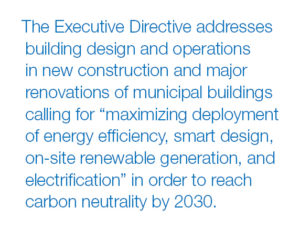Less than year after Mayor Eric Garcetti unveiled a Green New Deal for the city of Los Angeles, he is building on that leadership with a new Executive Directive that will help kick-start the decarbonization movement by accelerating the transformation of the city’s municipal buildings. The Directive is a prime example of how cities and other local governments can “lead by example” in climate action and decarbonize their own building portfolios.
Political actions such as this from Mayor Garcetti are aimed at creating healthier, more sustainable buildings, reducing operating costs, improving indoor air quality, and slashing carbon emissions in the built environment, which accounts for 39% of emissions in the United States. In L.A.’s latest greenhouse gas (GHG) emissions inventory, buildings accounted for 41% of citywide GHG emissions—the largest single source, and nearly twice as much as the emissions from transportation. The Executive Directive addresses building design and operations in new construction and major renovations of municipal buildings calling for “maximizing deployment of energy efficiency, smart design, on-site renewable generation, and electrification” in order to reach carbon neutrality by 2030.
Additionally, the Directive aims to significantly reduce the amount of carbon in municipal construction materials—such as steel, flat glass, and mineral wool board insulation—by adopting the Buy Clean California Act, which will establish Environmental Product Declaration (EPD) requirements to limit Global Warming Potential (GWP) for those materials. With this action, L.A. is the first California city to fully adopt the Act guidelines—although others such as Berkeley, Cupertino and Richmond have endorsed them—sending an important market signal that reducing embodied carbon is a priority action for this large building owner.
New Buildings Institute has been providing deep technical assistance and support in the stakeholder engagement process to help the city meet its goals. Specifically, NBI subject matter experts are providing strategic and technical guidance for improved implementation of the Existing Buildings Energy & Water Efficiency Program (EBEWE). In addition, NBI is working to engage stakeholders as L.A. actualizes its goals defined in the Green New Deal. The assistance provided by NBI and partners, Institute for Market Transformation and the Natural Resources Defense Council, is provided through the American Cities Climate Challenge and C40 support.
L.A. has also adopted the C40 pledge for net zero carbon buildings, which alongside other cities and mayors worldwide, pledges to enact regulations and/or planning policy to ensure new buildings operate at net zero carbon by 2030 and all buildings by 2050. Setting the city’s municipally owned buildings on a clear path to carbon neutrality works to fulfill that pledge.
In addition to addressing zero carbon buildings—both operational and embodied—the mayor’s Directive calls for carbon reductions in the electricity grid and transportation sector, as well as investigating options for low- and zero-carbon based renewable energy investment. The order also requires equitable access to clean power for low-income, multifamily, and affordable housing. Other provisions cover zero waste, zero-wasted water, resilient and cool cities, and air quality tracking.
Decarbonizing its entire building stock by 2050 is just one of many ambitious targets set out in L.A.’s Green New Deal, which was unveiled in April 2019 by Mayor Garcetti. Piggybacking on California’s goal to provide 100% renewable energy by 2045, Los Angeles responded to the global climate emergency by committing to power all of its municipal activities with carbon-free sources by 2045. With 4 million residents, L.A. is now the largest city in the nation to make such a commitment. Embedded in the Green New Deal is a commitment to address climate change without compromising jobs; looking to create 300,000 jobs in the green economy by 2035, and 400,000 green jobs by 2050.
While many people think of tailpipe pollution and smog when they think of L.A., the city has long been a climate action leader. Los Angeles produces more solar power than any city in America, according to a 2019 report commissioned by Environment America Research & Policy Center. The mayor’s office reported that by 2017, L.A. had managed to reduce carbon emissions by 25 percent from 1990 levels. Its per capita greenhouse gas emissions is about one-third of the national average, making it realistic that the City of Angeles could accomplish carbon neutrality by 2050 while providing jobs and equitable access to clean energy resources.
by Reilly Loveland, Project Manager bio
